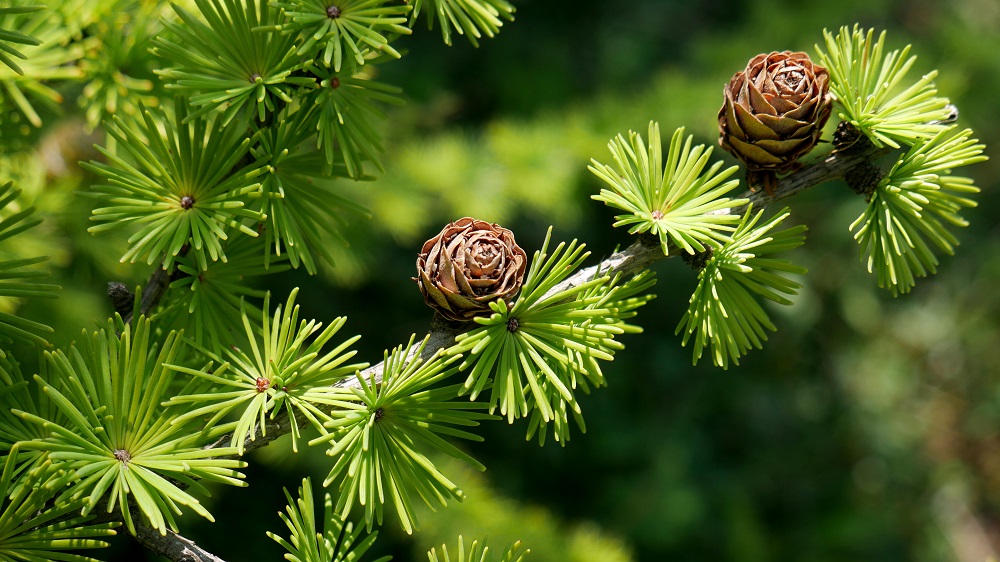Larix sp.
Common Name:
Larch

General Information:
Larix is an unusual genus, one of the handful of deciduous conifers. Larix bears bright green to bluish-green needle-like leaves that turn yellow in autumn. It has tiny cones which are purplish on most Larix species. Larches are pioneer trees and will not grow properly in the shade.
In areas with suitable temperatures, Larch is quite popular as bonsai. It is recommended by its quickly thickening trunk, and its foliage, which is fresh, bright green in spring and lovely golden yellow in autumn. Unlike many conifers, Larix cones are small and seem in proportion to most sizes of bonsai.
Family:
Pinaceae.
Lighting:
Semi-shade in summer, full sun otherwise.
Temperature:
Larches are cold-weather trees. Most varieties encounter difficulty in regions warmer than zone 6, and some are hardy in areas as cold as zone 2. The colder and drier the climate, the more compact the needle growth will be.
Watering:
Larch can be very sensitive to watering - as I’ve learned the hard way. Nursery grown trees must not ever be allowed to dry out, or to stand in water. Some larches grow naturally in boggy areas, and these have no problem remaining in water for days. They can eventually be trained to survive with less water, which is a good idea, as larches kept a bit dry develop shorter needles.
Feeding:
Every two weeks during growth, stopping for 6 weeks in midsummer, for developmental growth. Mature larch bonsai are fed very little, again with the hope of keeping needle length reduced.
Pruning and wiring:
Shorten the shoots during growth. The branches may also be pruned in autumn-winter, but always leave 2-3 buds on a branch. Wire from late spring-autumn. Another tip reinforced by experience - do not wire before bud burst as this tends to damage or kill larch cambium. During the growth season, larch responds extremely well to wiring, and it is easy to position a branch exactly where it is wanted. Larches are often seen as formal and informal uprights, and in forest plantings, although they are suitable for all sizes and styles except broom.
Propagation:
From seed sown in April/May - they take a while to germinate. They can be gathered from the late-ripening cones in autumn/winter. The cones must be left in the sun to open, and then the seeds may be shaken out. Cuttings may be taken in late summer from new shoots, and require the use of rooting hormone and a lot of moisture. In northern areas of America and Canada, larch is often naturally stunted by its growing conditions, and collecting larch for bonsai is quite popular.
Repotting:
Larch repotting depends much on circumstance. Young, unrestrained larches grow quickly, although the foliage grows at a greater rate than the root ball. The rate of larch growth can be slowed considerably through bonsai techniques, and by reducing feeding frequency. Tomlinson recommends repotting often, even annually, due to strong root growth. Other sources recommend repotting every 2-4 years, and gradual reduction of the root mass. Repotting should be done in early to mid-spring, or late summer. The books recommend transplanting before bud burst, but American larch may be best repotted after the buds have opened slightly, forming tiny “shaving brushes.” Eliminate unwanted branches to encourage rooting. Use fast-draining soil mix.
Pests and diseases:
Aphids, woolly aphids, bark beetles, caterpillars, rust, honey-fungus, canker, and the dreaded “mysterious wilting disease” which is always fatal to larch.
Some species suitable for bonsai:
Larix decidua: European Larch - this European native can grow to 75 feet tall, and is hardy in zones 4-6. It is a high altitude tree, and can even be found at altitudes above 8200 ft. The flowers are tiny - yellow for male and red for female.
Larix decidua ‘Diane’: contorted larch.
Larix x eurolepis (decidua x kaempferi): Dunkeld larch - a hybrid between the European and Japanese species.
Larix kaempferi (also called L. leptolepis): Japanese larch - the Japanese variety of larch is similar to the European larch in size. It is hardy in zones 5-6 and has bluish-green needles.
Larix laricina: American larch, tamarack, hackmatack - smaller and hardier than the previous larches, the American larch grows to 60 feet, and can withstand zone 2 temperatures! It has finely flaking dull pink or pink-brown bark. This Larix has significant flowers, which are tiny, but bright red.
Larix sibirica: Siberian larch
Bibliography:
Jahn (ed.) “The Simon and Schuster Guide to Bonsai” Owen’s “Bonsai Identifier”
Resnick’s “Bonsai”
Samson’s “Creative Art of Bonsai”
Tomlinson’s “Complete Book of Bonsai”
No. 2 1996 issue of “International Bonsai” dedicated to Larch.
Species information is from Mitchell’s “American Nature Guides: Trees,” and Thomas (ed.) “The Hearst Garden Guide to Trees and Shrubs.”
Compiled by Sabrina Caine Edited by Thomas L. Zane
